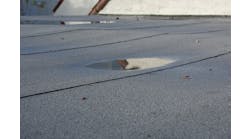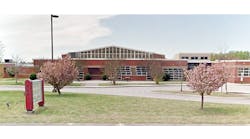Have you ever seen a roof with shingles that appear to bulge at the joints of insulated roofing panels? When sunlight washes across the roof, you can see the outline of every insulated panel. The term “picture framing” was coined to describe this phenomenon. Something appears to be wrong, even though there are no leaks or other failure.
Picture framing may be just a matter of appearance. Properly installed insulated roofing systems with shingles can “picture frame,” most commonly when moisture causes the felt underlayment to expand. But this is no consolation to a school official who has a new roof that looks flawed and a nervous feeling that the joints will leak before the warranty is up. Here is an explanation of how it happens.
Insulation and moisture
Manufacturers of fiberglass or organic mat roofing shingles warn that installing them over standard non-vented polyisocyanurate roofing panels may shorten the warranty life of the shingles. The heat buildup tends to accelerate the aging process. To avoid the problem, the shingle industry recommends using vented systems.
The usual vented panel construction consists of a layer of plywood or OSB (oriented strand board), ¾-inch or 1½-inch clear vertically aligned airspace (depending on the distance between the eave and the ridge) on polyisocyanurate insulation. The manufacturing process usually includes a fiber-reinforced facer (moisture retarding) on both sides of the insulation. This protects the product during shipping and installation, and provides a glue surface to attach the blocking and nail board.
Polyisocyanurate insulation is a generic description of an open-cell expanded rigid foam insulation product that is available in a wide variety of thicknesses. It has the highest initial insulating resistance per inch of standard foam insulating products. However, its resistance can diminish with age and moisture content. The insulation must be protected from water and humidity. It also must be protected from ultraviolet light, which breaks down the foam. Once installed properly under other building products, such as roof shingles, the insulation theoretically is well protected.
Using asphalt-saturated roofing felt is the industry standard for shingle underlayment.
In practice, roofing felts allow the builder to cover a newly installed wood roof deck quickly and protect it from moisture until the shingles can be installed. The felts lie flat on the decking; if they are exposed to moisture, they absorb some of it and buckle in “waves.” Once felt has absorbed moisture, it does not appear to be flat, even after drying out.
Buckles and bulges
If your roof experiences picture framing, and you determine that it is not related to panel movement, the most likely cause of the shingles lifting at the insulation panel joints is expansion of the felt underlayment. Generally, this occurs only at the joints between insulated panels. The ⅛-inch gap between nail boards on properly installed vented insulation panels allows moisture in the vent space under the nail board to rise and be absorbed by the felts. The roofing felts expand by bulging upward and lifting the shingles.
The vented air space below the nail board contains moisture. Air and moisture is drawn through the eave vents and circulated up through the system to the ridge vents. Outdoor moisture is present in the form of humidity, mist, fog, rain and condensation.
To make matters worse, the polyisocyanurate insulation edges are right below the joints. The unprotected edges are capable of absorbing and slowly releasing moisture. They are a natural sponge.
Some people believe that if shingles buckle, that can be viewed as deck movement. In the roofs exhibiting picture framing, often there is no evidence that the plywood or OSB nail boards have expanded or shifted out-of-level. In addition, the shingles at the panel joints lie flat when removed and placed on a flat surface. The only component that is deformed is the roofing felt.
Some solutions
The Asphalt Roofing Manufacturers Association says installing asphalt-saturated felt helps minimize picture framing. Although use of heavy felts clearly will help obscure decking irregularities, insulated panel manufacturers appear to have very good control over the uniformity of their product's thickness during manufacturing.
Some roofing manufacturers have developed fiberglass-reinforced roofing felts to help stabilize buckling that results from moisture absorption. These may, if properly installed, discourage picture framing.
Many roofing panel system manufacturers recommend, but do not require a vapor barrier. For buildings that produce less moisture, the need for a vapor barrier is a judgment made by the professionals detailing the building. Where practical, vapor barriers should be used to slow the transfer of moisture from a warm environment to a cooler environment. This impedes condensation.
In practical terms, it is difficult to install a poly vapor barrier over roofing deck; walking on it is likely to cause damage to the film and increase the chances that the installer will slip. Even in the best of applications, the roof fasteners are going to penetrate and possibly deform the vapor barrier. For projects requiring vapor barriers with wood decks, consider sealant between panels. On projects with metal decks, consider sealant at panel overlaps.
Roofs installed over ice and water barriers do not picture frame. Ice and water barriers do not expand when exposed to moisture. However, placing ice and water barriers over non-vented systems can trap moisture between the insulation and nail board. This is likely to rot the nail board and allow mold to grow. Use of a vented system allows the vent space and the nail board to dry out.
NOTABLE
▪ 15, 30In pounds, the two common weights available for roofing felts.
▪ 30°F to 140°FTemperature swing in air space of a typical roof in some geographic areas.
▪ 1/6 INCHVented insulation panel system manufacturers generally hold the nail boards this much space back from the edge of the insulation panels to allow for nail-board expansion after installation.
▪ ⅛ INCHA properly installed roofing panel system maintains this space between installed panels.
Sidebar: Getting results
How to ward off picture framing:
-
Always use appropriately vented panel systems or create a built-up vented space above the insulated panels and include eave and ridge venting.
-
Wherever practical, use a vapor barrier under the insulation panels.
-
Increase the number of panel fasteners, particularly along the edges.
-
Do not install asphalt-saturated roofing felts unless they are reinforced to prevent bulging, buckling and lifting shingles.
-
If the area of roofing is small, consider using an ice and water barrier over the entire roof (under the shingles). This should be done only over vented insulation/nail board panel systems; it may make roof replacement more difficult.
Wyeth is an architect practicing in Ivoryton, Conn.

